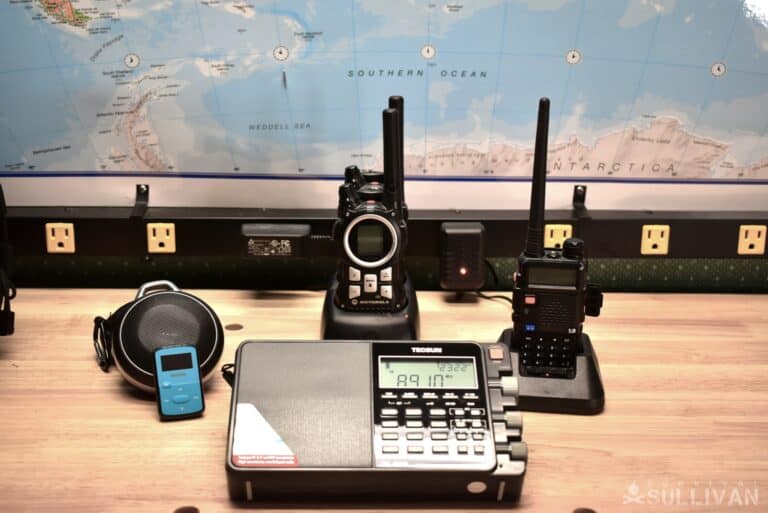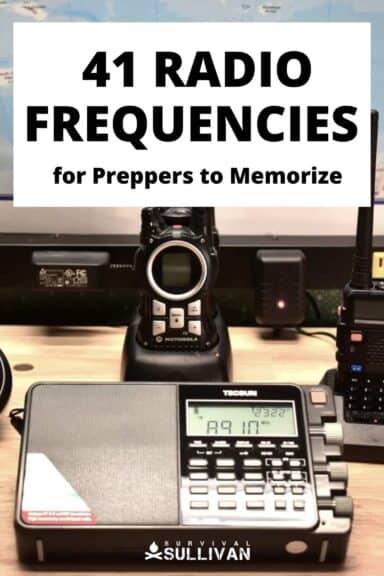Probably the single greatest advantage that personal radios have for preppers is that they offer you a completely self-contained method for long-distance communication in emergencies.

The internet can be wrecked, phone lines can be down, and power can be out everywhere, but as long as you can power up your radio, you can rest assured there are other people out there on the airwaves.
This can truly be a comfort when everything else seems to fall apart, and whether you’re just trying to get information on the situation or desperately need help for you or someone else, a radio will get it done.
But you’ve got to know which frequencies to tune in to get the information you need- depending on the circumstances.
The following frequencies are ones all preppers should commit to memory whether you use Citizens Band (CB) or amateur radio (ham radio). Program them into your set as an additional precaution, but make sure you know them by heart just in case.
Caution: These Frequencies are for Emergency Use Only
Really quick, before we get to the list. There are several frequencies on this list that you should only transmit on in a dire emergency.
Some of these will be for a matter of courtesy, as you don’t want to clog up the air with unnecessary chatter.
Others, specifically those used by government agencies, the military, and non-governmental organizations (NGOs), might entail major consequences for anything but true emergency use, and maybe not even then!
Make sure you assess the situation correctly and think twice before transmitting on these channels, but as always, it’s possible to listen in and gather valuable intel from them, especially if something is going seriously wrong in your area.
CB Bands
Channel 6 27.025 MHz
This channel is commonly used by skippers, people using a CB radio who are attempting very long-distance communications or DXing.
Typically used for recreational purposes, like trying to contact incredibly faraway places in ideal times of atmospheric activity and weather conditions. Nonetheless, it can be important if all you have is a CB radio and there is a regional or national, or God forbid, global disaster.
Channel 9 27.065 MHz
This is the designated CB radio channel for emergencies and traveler assistance, however you’re traveling.
This channel is supposed to be monitored continuously by police and other first responders even though the only time they communicate on it is if they have to make contact with whoever is using the channel for emergency purposes.
Definitely one to keep in mind if you’re on the road, and worth a try if you have no other options for contacting help in a disaster.
Channel 10 27.075 MHz
A channel commonly used by truck drivers and other professional drivers traveling on regional roads. Can be a good way to pick up news or some help if you are near a highway.
Channel 13 27.115 MHz
A commonly used CB channel both by RVs and also boats. If you’re on the water or near the water, this one will be a mainstay even in emergencies. Just remember to go to channel 9 if you’re trying to contact first responders, though.
Channel 17 27.165 MHz
Similar to channel 10 above, but used by truckers and professional drivers who are traveling north or south via interstate.
Channel 19 27.185 MHz
Exactly the same as channel 17, used by professional drivers on interstates but this time heading east or west.
Channel 21 27.215 MHz
An alternate channel used by truckers and other drivers traveling on regional roads. Consider checking these channels if you need updates or need to attempt to summon help and are near a regional highway or turnpike.
Ham Frequencies
20, 40, and 80 meter bands
These are the designated bands for the National Traffic System, and the frequencies there are used by networks of ham operators to handle related message traffic for all emergencies, and particularly in and out of affected areas that might be experiencing communications disruptions.
34.90 MHz
This is a nationwide emergency channel for the National Guard. If you’re in the middle of a local or regional emergency and the National Guard is responding, keep this one in mind as you can get in touch with someone that’s monitoring the situation and can, hopefully, help you.
39.46 MHz
This is the emergency communications channel for local and state police pretty much everywhere, and one you should definitely keep in mind if other methods of communication are down.
Keep in mind, it’s highly likely that this channel will get clogged in a major emergency, but it’s still a great way to get updates on an emergent situation.
Also regularly employed for inter-department police emergency communication. If the situation is bad enough that it brings separate local or state agencies together, this can be a great channel to monitor to keep up with the unfolding scenario.
47.42 MHz
This channel is specifically utilized by the Red Cross for nationwide relief operations. Anytime the Red Cross gets sent to an area you can be sure that aid and assistance will soon start flowing into affected populations and survivors. A great frequency to check if you need supplies or medical assistance during a grid down or societal collapse situation.
121.50 MHz
The officially designated frequency used for international aerospace emergencies. Highly situational, but a good one to know just in case.
138.225 MHz
This is a big one. The primary Federal Emergency Management Agency (FEMA) frequency for active disaster relief operations. Anytime FEMA has been deployed and is putting in work, you can check in on this one for updates and, in a pinch, to contact them.
146.520 MHz, 2 meter band
One of the most common calling frequencies used by ham operators to establish initial communications during major emergencies. They serve as starting points to get traffic and sometimes messages where they need to go.
Make it a point to avoid extended communications on this frequency, especially during times of distress.
154.28 MHz / 154.57 MHz / 154.60 MHz
Local fire department emergency communications frequency. If all else fails, get in touch with the fire department using one of these. It goes without saying; don’t mess around on this channel for any other reason!
154.295 MHz / 154.280 MHz / 154.265 MHz
These frequencies are used for inter-department fire services communications.
155.160 MHz
This frequency is routinely used at the state and local levels for search and rescue operations and coordination. If you’re lost in the backcountry or have essential info on a missing person or persons, consider checking in here.
155.475 MHz
This frequency is kind of a grab bag for state and local-level police communications. Used more or less frequently depending on where you are, but definitely one to check in on when things have gone seriously haywire.
156.75 MHz
This is a great frequency to keep in mind if you live near the coast, one of the Great Lakes, or any other large body of water or river; this is the international maritime weather alerts frequency.
156.80 MHz
A companion channel to the previous one, this is the international maritime safety, calling, and distress frequency. Try to keep this one clear for boater and ship use.
162.40 MHz to 162.55 MHz / 163.275 MHz
All these frequencies are NOAA weather bulletin and broadcast channels. If you need updates on any kind of weather, including severe weather, atmospheric phenomena, and solar activity, these should be your first stop.
163.4875 MHz
This is another nationwide emergency frequency for the National Guard.
163.5125 MHz
Another one of my favorites. This is a national disaster preparedness channel for the entirety of the armed forces. If something major is happening, you can glean some good information off of this one.
168.55 MHz
This channel is used predominantly by civilian interfacing federal agencies during emergencies and times of disaster.
243.00 MHz
An emergency channel specifically designated for military aviation. Not as helpful as the other ones listed above, but still a good one to know particularly if you are near a high-traffic corridor for aircraft.
311.00 MHz and 319.40 MHz
Channels used by the United States Air Force while in flight. Again, do not mess around on these!
317.70 MHz and 317.80 MHz
Like the two above, these two channels are used for U.S. Coast Guard aerial operations.
340.20 MHz
Same thing here; an active channel for U.S. Navy aircraft.
409.625 MHz
Just in case frequency; this is the National communications channel for the U.S. Department of State.
446.000 MHz, 70 CM band
Another frequently used ham channel for initial contact and coordination during disasters and major emergencies, just a different band. Remember, find out what you need to find out and avoid long calls during times of trouble.
462.675 MHz
This is the General Mobile Radio Service (GMRS) designated channel for traveler assistance and emergency calling.


Tom Marlowe practically grew up with a gun in his hand, and has held all kinds of jobs in the gun industry: range safety, sales, instruction and consulting, Tom has the experience to help civilian shooters figure out what will work best for them.

Don’t bother memorizing any fire department VHF analogue radio freqs. Nobody monitors those in North America anymore. Everything went P25 high Meg digital encryption compliance over a decade ago. You ain’t connecting with that with your motorola walkabouts. Police, Fire, Sheriff pretty much everybody is P25 compliance.
Nice list of freq but no information about mode (am,fm,ssb)…